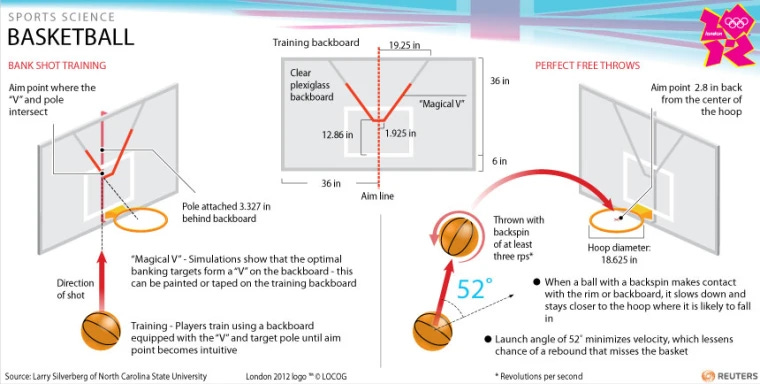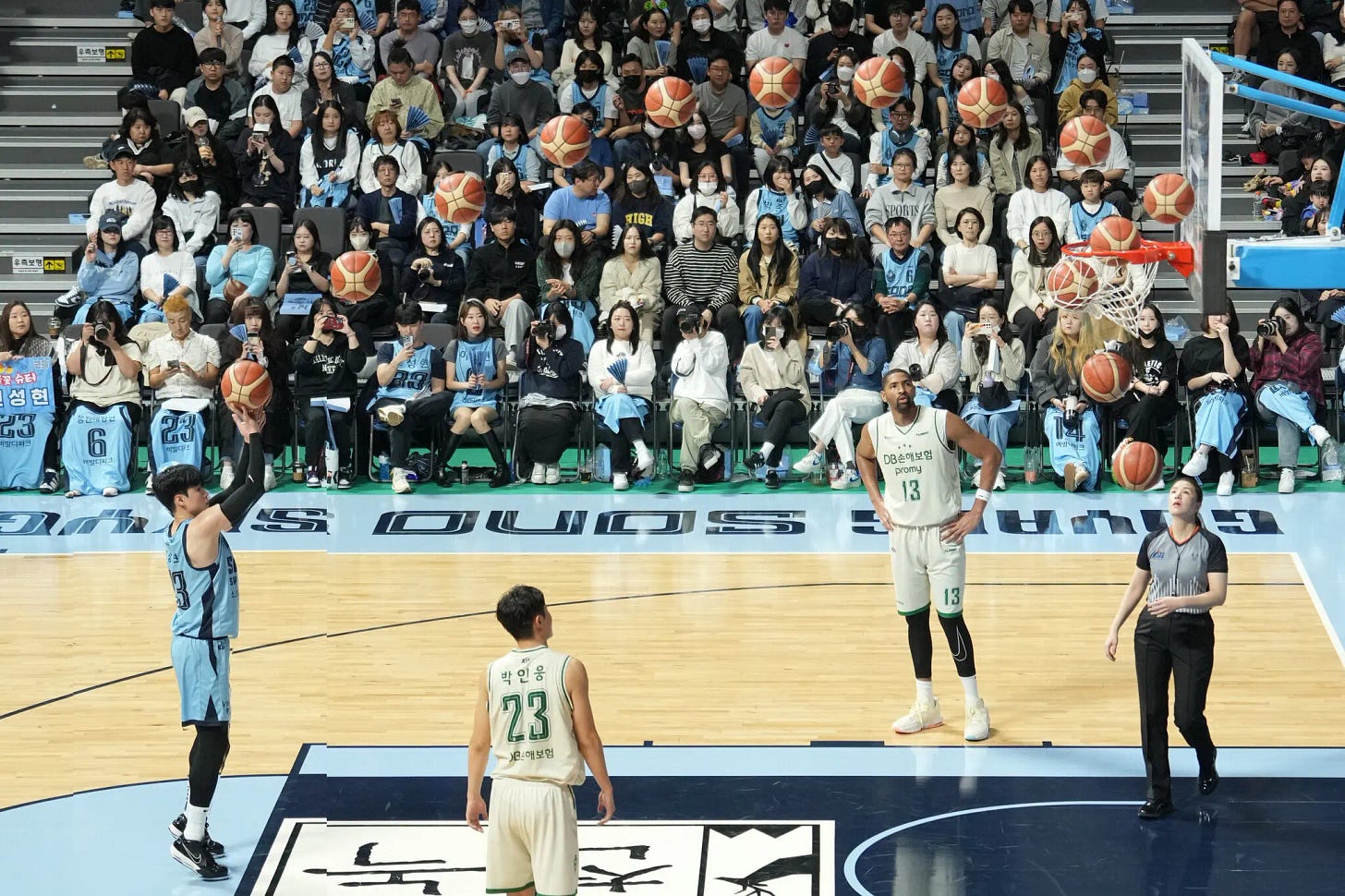When the going gets tough, the tough shoot hoops. So that’s what I did.
On Sundays I get to play basketball at Parque Juarez with my fellow gringos. Nothing serious - more social than competitive, and this last weekend, I finally won a game of OUT. I did it by sticking with the bank shot.
If hoops has a whisper, it’s the sound of a ball kissing the backboard before falling softly through the net. Not a swish, not a thunderous dunk, but something humbler - part geometric execution, part physics solution - and a gentle reminder that force isn’t always better than angle.
Here’s the thing, the bank shot isn’t a throwback. It’s a cheat code disguised as a relic.
Banker.
You call that?
*To View, Click on Watch on YouTube Icon, Lower Left
It’s not sexy. It’s not viral. It’s not even taught much anymore. But it is efficient, artful, and a joy to master. And now, thanks to some international influence, a convergence of data and a few unbothered NBA stars, it’s staging a quiet return.
There’s something deeply satisfying about a solid bank shot. It’s definitely a vibe. Not just the sound of it, but the feeling. It’s almost rebellious now, like pulling out a flip phone in a sea of smartphones. All net not needed, just give me the bucket.
It’s stylish in a way that’s hard to explain. Luka Dončić uses it as part of his slow-motion ballet. Anthony Edwards uses it like a body punch in boxing, unexpected and draining. Even Caitlin Clark, the queen of the Logo Three, will sneak in a bank floater just to remind you she’s got a full arsenal at her disposal.
On paper, it’s simple: you shoot the ball off the backboard instead of aiming directly for the hoop. The ball hits the glass and, ideally, drops through. The beauty lies in what this requires - precision in angle, arc, and spin. There’s more room for error in distance, but less room for error in trajectory.
A professor at North Carolina State University, Larry Silverberg, published a study in The Journal of Quantitative Analysis in Sports that looked at millions of simulations and found something old school hoopers already knew - from certain spots on the court, especially within 12 feet and off center, the bank shot actually improves your odds. And no surprise, shots taken from 35 to 55 degrees from the baseline are often better made off the glass than straight in.
In Wired’s 2011 analysis of this data, the researchers described an ideal “V shaped” area on the backboard for bank shots. It’s higher and more subtle than that old painted square would suggest, meaning many of us have been off target for years.
Tim Duncan built a Hall of Fame career off the bank shot, earning the nickname “The Big Fundamental” with his cool, mechanical use of the glass. But in the decade after his retirement, the move seemed to fade. The analytics movement devalued the midrange game, where bank shots most often happen. The three-pointer, with its higher points-per-shot value, took over.
But something is happening now.
As Forbes recently noted, stars like Luka Dončić and Anthony Edwards are leaning back into the bank shot, not as a gimmick, but as a weapon. Dončić, with his pace control and deep repertoire of shots to draw on, often uses it when defenders are closing hard, giving himself a bigger margin of error. Edwards uses it to finish through contact. Neither is trying to emulate Bank God Tim Duncan; they’re finding their own way into the move.
And in South Korea, K Pop isn’t the only thing happening. The bank shot didn’t just stage a return. It never left.
When the New York Times profiled their basketball scene they found something remarkable, South Korea’s has a full on love affair with the bank shot, especially at the foul line. Of special note is an interesting trend from the Korean Basketball League - where a number of players are 80%+ from the free throw line - only shooting bank shots.
Jeon Seong-hyen, a guard with the Goyang Sono Skygunners, making a free throw during the opening game of the season. Credit…Chang W. Lee/ NYT
Young players there are obsessed with it. Not dunks, not Steph Curry step-backs but bank shots. They see them as more reliable, more elegant, more satisfying.
At the Anyang Jung Kwan Jang Red Boosters’ youth camp, bank shots are not just taught, they’re revered. Young players practice them with surgical discipline. Coaches insist on specific release points and angles. To miss a bank shot is to disrespect its logic.
Where did this come from? Perhaps it's a mix of cultural values - precision, humility, control - and basketball history. The NBA was once full of bank shot artists, from Sam Jones to Larry Bird to Duncan. Maybe South Korea just never got the memo that the move was “outdated.” And maybe they were right not to. Sometimes it’s okay if the message gets lost in the mail.
But let’s circle back to the research.
At their core, bank shots are a practical application of projectile motion and energy transfer. When a basketball is shot, it follows a parabolic trajectory influenced by gravity, initial velocity, and angle of release. Introducing the backboard adds another layer: the ball's interaction with a solid surface.
The researchers made a few assumptions while conducting the study. They used a men’s basketball, which is slightly bigger and heavier than a women’s basketball; launched the simulated shots from 6, 7, and 8 feet above the ground; and imparted 3 hertz of backspin, which means three revolutions per second on the shots. Previous research showed that 3 hertz backspin was optimal for free throws.
A few takeaways. Spin matters. A ball with proper backspin hits the glass and slows down, deadening the bounce and increasing the chances it drops softly in. Angle is everything. The bank shot works best from specific positions, notably the “wing” or 45-degree angle spots on either side of the key. Their findings revealed that bank shots could be up to 20% more effective than direct shots from certain areas on the court, particularly within 12 feet of the basket. And last but not least, Touch is king. Hard shooters struggle with bank shots. It’s a move for players who understand tempo, who feel the rhythm between hand and glass.
But the bank shot isn’t universally helpful. It rarely makes sense from straight on. And the farther out you get, the less useful the backboard becomes. Physics gives way to brute trajectory. Outliers exist, however, and as seen in the video below, physics seldom restrained Kobe Bryant.
Let’s be honest. The rise of the three point shot, the cult of the step back, and the glamorization of isolation all conspired to make the bank shot seem well, a little dated.
That perception, however, was less than comprehensive. Because the bank shot isn’t just effective, it’s one of the few shots in basketball that can forgive. A miss that’s an inch too far or short can still drop in off the glass.
And here’s where it folds into ensōnomics - in an era obsessed with perfection, it makes room for imperfection. The shot doesn’t have to be exact - sometimes the player just needs to be a little clever. You just have to take the shot.
At the most basic of levels, the bank shot is a teacher.
It teaches geometry. It teaches how spin changes behavior. It teaches where your footwork places you and how to adjust. It forces players to look not just at the rim but at the space around it.
It also builds confidence in the midrange, a shot that analytics say to avoid, but that defenses increasingly give away. The irony? The midrange may be inefficient on average, but for certain players in certain situations, it’s available. And if you can bank it? It’s yours.
Will the bank shot ever dominate highlight reels again? Probably not. But that’s okay. It’s not a viral move, it’s a reliable one.
And maybe that’s exactly what basketball, in all its over-optimized chaos, needs more of: something dependable, thoughtful, quietly clever. Something that turns the hard thing into the smart thing.
So if you ever happen to find yourself at the gym or outdoor court shooting around with a kid who wants to dunk or hit a logo three and can’t quite get there, maybe teach them the bank shot. Not as a consolation, but as a craft.
That glass isn’t going anywhere. Might as well use it. And next time, go ahead and call it.
Fishermen know that the sea is dangerous and the storm terrible, but they have never found these dangers sufficient to keep them ashore. They leave that philosophy to those who like it. Let the storm rise, the night descend - which is worse, danger or the fear of danger? Personally, I prefer reality, the danger itself.
Letter from Vincent van Gogh to Theo van Gogh
The Hague, 14 May 1882
There was another warm up to the main event parade today and I was lucky enough to have access to a friend’s roof. And of course, there is also a Pokemon X Van Gogh.
The Endsō





The game has changed tremendously since the "glory days" of the 70s and 80s but it's great to see the top teams distributing the ball again. I credit Coach Pop and the Spurs with that resurgence. Still hate isolating the top player with the ball down when the game is tight. Pass the damn ball and bank it to win !!!!